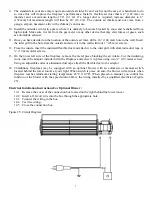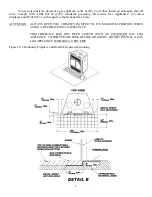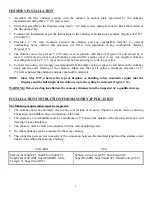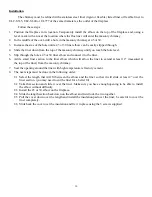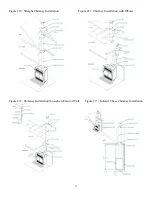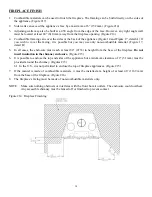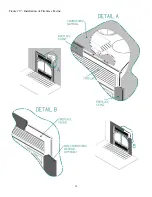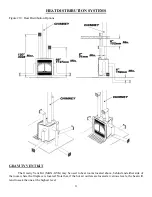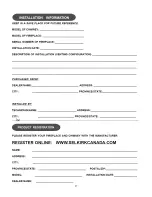
20
CREOSOTE
When wood burns slowly, it produces tar and other organic vapors which combines with humidity to
produce creosote. Creosote vapor condenses in the chimney left relatively cool by the slow fire and coats the
inside of the flue with residue. When creosote ignites, it produces a red-hot, extremely dangerous fire.
It is therefore recommended to make small, brightly burning fires rather than lazy, smoldering fires. Not
only will it keep your glass doors and flue cleaner but, what is most important, it will lessen the likelihood of
chimney fires.
CHIMNEY FIRE SAFETY PROCEDURES
What to do if you suspect a chimney fire has started:
1. Close the fireplace doors.
2. Alert everyone in the house.
3. Call the Fire Department if necessary.
4. Put out the fire in the fireplace with a dry-chemical extinguisher, baking soda, sand or ashes
. (Never use
salt because it is corrosive, nor water because it could cause a steam explosion.)
5. Make sure the sparks coming from the chimney do not set fire to the roof.
6. Before reusing the fireplace, have it inspected by the Fire Department.
MAINTENANCE
1. Clean metal trim with soapy water and a soft cloth. Do not use any metal polish or abrasives.
2. Keep the glass clean. Dirty windows will make the fireplace overheat. Wait until the glass is cool before
attempting to clean it. Wash the glass with a fireplace glass cleaner, dishwashing liquid or just soap and
water. Spray the cleaner on a soft cloth and not on the glass, since overspray may discolor coating or metal
plating (not covered by the warranty).
DO NOT
use steel wool, soap pads (S.O.S.) or any other abrasive
product since these may scratch the glass.
3. To remove the ashes, lift the log support. Put the ashes in a metal container with an airtight lid. Place the
container on a non-combustible surface away from any flammables until the ashes are cold.
4. Before each heating season, inspect the interior and exterior of the fireplace and chimney for any defects or
deterioration.
5. To reduce the risk of chimney fires, keep it relatively clean and regularly check for creosote buildup. To
open the rain cap, just unscrew it counter-clockwise. Any layer of creosote greater than 1/8” (3 mm) thick
should be swept. Use a plastic brush to avoid scratching the flue.
Summary of Contents for Chardonnay
Page 11: ...11 Figure 7 Minimum Chimney Height...
Page 12: ...12 Figure 8 Masonry Chimney Installation...
Page 15: ...15 Figure 15 Chimney Enclosure Chimney enclosure USA and Canada Chimney enclosure Canada only...
Page 16: ...16 Figure 16a Mantel Positioning...
Page 17: ...17 Figure 16b Combustible materials positioning A 48 in B Radius of 84 in C 84 in Min...
Page 18: ...18 Figure 17 Installation of Fireplace Facing...
Page 26: ...26...
Page 27: ...27...
Page 28: ...28...


